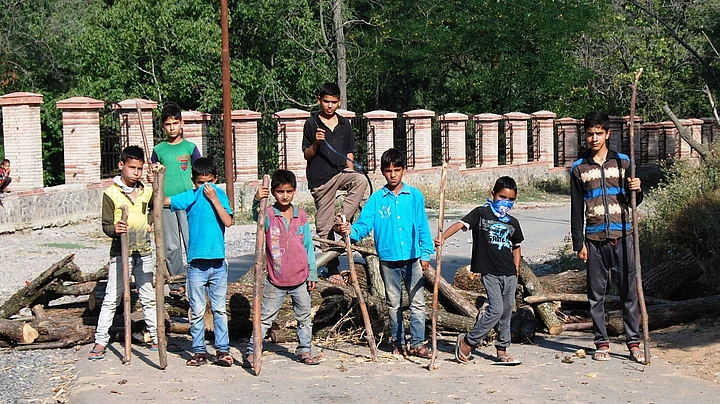Not much has changed, it seems, since the summer of 2010, when young Kashmiri protesters took to the streets and hurled stones at army soldiers. It was a unique protest, not just because a stone was used to express anger and anguish but also the demographic profile of the protesters took everyone by surprise, for they included young graduates, doctors and engineers who were enraged at years of injustice and complete denial by Delhi.
The year 2016 marks six years since 2010; six years since Kashmir witnessed a violent civil unrest. The protagonists of the latest protests are once again young stone-pelters, braving bullets and deadly pellets of the security forces. So far, more than 52 civilians have lost lives and over 3,700 have been injured, following the weekly protest calendars notified by united Hurriyat leaders.
The Quint visited areas that witnessed heavy stone pelting, like downtown Srinagar, Nowgam, Batamaloo and Bemina in Srinagar city to talk to the young people and understand why they risk their lives and what motivates them to do so.
Batamaloo: ‘Our Only Weapons are Stones’
After spending almost an hour trying to convince Amir Shah (name changed) to talk, he agreed to an interview, only on the condition of anonymity.
Amir says, “I only pelt stones because we want azadi from India. That is our sole motive. We want to free ourselves from the clutches of New Delhi.”
No one is funding us. We are an oppressed lot – day-in and day-out, we get brutally assaulted by the CRPF and the police. That is why we pelt stones. Neither Geelani, Mirwaiz nor Yasin Malik fund us. They should set their house in order first, then we can talk to them. It is our (youth) struggle, if they (Hurriyat) want, they can stay away from all that is happening now.Amir Shah (name changed), Batamaloo resident
Upon leaving, Amir shouts at us from a distance: “We do not have any weapons. We
are not terrorists. Our only weapons are stones. Stones are this generation’s AK47.”
Bemina: ‘Pellets are Used on Animals, Not Humans’
Asif (name changed), 24, is a BCom final year student. Wearing rugged jeans and a blue T-shirt, he is willing to talk but did not agree to be photographed.
You know how our youth are being killed and maimed by pellets on a daily basis now, for no fault of their own. The killing of innocent Kashmiris is the sole motivation behind our stone pelting. New Delhi has always deprived us of our rights. We should get back our rights at any cost. Living with dignity is everyone’s fundamental right and Indian security forces always trample on our fundamental rights. There is no dignity in Kashmir. We are left with no option but to pelt stones.Asif (name changed), Bemina Resident
Asif breathes heavily while speaking, showing clear signs of
trauma or torture.
Pellets are used on animals and not on humans. In Kashmir, pellets are used unabatedly. It clearly shows that Kashmiris are not humans and not a part of India.Asif
Nowgam: ‘Don’t Pelt Stones for Enjoyment’
Yasir (name changed) has been involved in stone-pelting since the 2010 unrest and is not afraid of the consequences any more. He was fired upon by the police at Natipora chowk in Srinagar. Two months later, he was arrested from his home.
I do not pelt stones for enjoyment. It is because of sheer harassment that we are pelting stones at them. When I was arrested in 2010, Police demanded Rs 15,000 for my release and said if you don’t pay up you will be booked under the Public Safety Act (PSA). It was harassment and nothing else. They beat me at home and at the police station. They took payment on the fourth day and released me on the fifth.Yasir (name changed), Nowgam Resident
Downtown: ‘Won’t Stop Even if We Die’
Often referred to as the “Gaza Strip” of Jammu and Kashmir, Srinagar’s downtown area remains one of the most volatile areas in Kashmir. Bricks, broken windows, stones, and sticks are a common sight in this district.
Ishfaq Ahmed (name changed) is a 26-year-old post graduate student with a Master’s in Technology Management (MTM) from Chandigarh University.
Few days ago, my friends and I went to a nearby ground to play cricket. When we reached the main square, CRPF and Special Task Force (STF) troopers were beating passers by mercilessly. An elderly person was also beaten. We tried to stop them but they started to beat us as well. Since that evening, I along with my friends pelt stones on a daily basis now. Even if we die, we won’t stop.Ishfaq Ahmed (name changed), Srinagar Resident
He was furious when I asked a few questions on whether the protests were allegedly funded by an organisation/group or leaders.
“Why are you asking such irrelevant questions? We do not pelt stones for money. We have never seen or met Geelani or Mirwaiz or Yasin Malik. When we have never met them how can they fund us?” Ishfaq asks angrily.
Psychological Insecurity
Dr Mushtaq Ahmad Margoob, Professor and Head, Postgraduate Department of Psychiatry, Institute of Mental Health and Neuro Sciences Kashmir (IMHANS-K), says: “2016 is exactly like 2010. There is a thought process that is passed on from community to community or from one generation to the other, this is what we call trans-generational transmission of trauma. And it has happened in the case of Kashmir. Youth here feel threatened. Today is July 2016, but also remember what happened in July 1931 in Kashmir. From that July till this July, Kashmiris have only seen death and destruction. These youth know that they are confronting death by pelting stones, but they still do knowing it is for survival.”
(The writer is a Srinagar-based freelance journalist. He can be reached at @DaanishNabi)
Also read:
Mehbooba’s Healing Touch Policy Hit as Kashmir Remains on Edge
Burhan Wani May Have Been Betrayed by His Hosts
